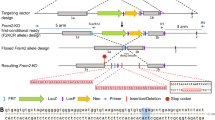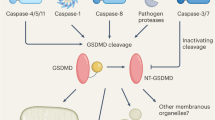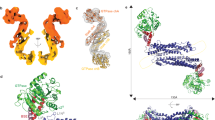Abstract
Cell adhesion to extracellular matrix (ECM) proteins is crucial for the structural integrity of tissues and epithelial-mesenchymal interactions mediating organ morphogenesis1,2. Here we describe how the loss of a cytoplasmic multi-PDZ scaffolding protein, glutamate receptor interacting protein 1 (GRIP1), leads to the formation of subepidermal hemorrhagic blisters, renal agenesis, syndactyly or polydactyly and permanent fusion of eyelids (cryptophthalmos). Similar malformations are characteristic of individuals with Fraser syndrome and animal models of this human genetic disorder, such as mice carrying the blebbed mutation (bl) in the gene encoding the Fras1 ECM protein3,4. GRIP1 can physically interact with Fras1 and is required for the localization of Fras1 to the basal side of cells. In one animal model of Fraser syndrome, the eye-blebs (eb) mouse, Grip1 is disrupted by a deletion of two coding exons. Our data indicate that GRIP1 is required for normal cell-matrix interactions during early embryonic development and that inactivation of Grip1 causes Fraser syndrome–like defects in mice.
This is a preview of subscription content, access via your institution
Access options
Subscribe to this journal
Receive 12 print issues and online access
$259.00 per year
only $21.58 per issue
Buy this article
- Purchase on SpringerLink
- Instant access to full article PDF
Prices may be subject to local taxes which are calculated during checkout





Similar content being viewed by others
References
Fuchs, E. & Raghavan, S. Getting under the skin of epidermal morphogenesis. Nat. Rev. Genet. 3, 199–209 (2002).
Vainio, S. & Lin, Y. Coordinating early kidney development: lessons from gene targeting. Nat. Rev. Genet. 3, 533–543 (2002).
McGregor, L. et al. Fraser syndrome and mouse blebbed phenotype caused by mutations in FRAS1/Fras1 encoding a putative extracellular matrix protein. Nat. Genet. 34, 203–208 (2003).
Vrontou, S. et al. Fras1 deficiency results in cryptophthalmos, renal agenesis and blebbed phenotype in mice. Nat. Genet. 34, 209–214 (2003).
Dong, H. et al. Characterization of the glutamate receptor-interacting proteins GRIP1 and GRIP2. J. Neurosci. 19, 6930–6941 (1999).
Sheng, M. & Sala, C. PDZ domains and the organization of supramolecular complexes. Annu. Rev. Neurosci. 24, 1–29 (2001).
Hung, A.Y. & Sheng, M. PDZ domains: structural modules for protein complex assembly. J. Biol. Chem. 277, 5699–5702 (2002).
Harris, B.Z. & Lim, W.A. Mechanism and role of PDZ domains in signaling complex assembly. J. Cell Sci. 114, 3219–3231 (2001).
Setou, M. et al. Glutamate-receptor-interacting protein GRIP1 directly steers kinesin to dendrites. Nature 417, 83–87 (2002).
Bladt, F., Tafuri, A., Gelkop, S., Langille, L. & Pawson, T. Epidermolysis bullosa and embryonic lethality in mice lacking the multi-PDZ domain protein GRIP1. Proc. Natl. Acad. Sci. USA 99, 6816–6821 (2002).
Tillet, E., Ruggiero, F., Nishiyama, A. & Stallcup, W.B. The membrane-spanning proteoglycan NG2 binds to collagens V and VI through the central nonglobular domain of its core protein. J. Biol. Chem. 272, 10769–10776 (1997).
Stegmuller, J., Werner, H., Nave, K.A. & Trotter, J. The proteoglycan NG2 is complexed with alpha-amino-3-hydroxy-5-methyl-4-isoxazolepropionic acid (AMPA) receptors by the PDZ glutamate receptor interaction protein (GRIP) in glial progenitor cells. Implications for glial-neuronal signaling. J. Biol. Chem. 278, 3590–3598 (2003).
Heinonen, S. et al. Targeted inactivation of the type VII collagen gene (Col7a1) in mice results in severe blistering phenotype: a model for recessive dystrophic epidermolysis bullosa. J. Cell Sci. 112 (Pt 21), 3641–3648 (1999).
Winter, R.M. Fraser syndrome and mouse 'bleb' mutants. Clin. Genet. 37, 494–495 (1990).
Darling, S. & Gossler, A. A mouse model for Fraser syndrome? Clin. Dysmorphol. 3, 91–95 (1994).
Swiergiel, J.J., Funderburgh, J.L., Justice, M.J. & Conrad, G.W. Developmental eye and neural tube defects in the eye blebs mouse. Dev. Dyn. 219, 21–27 (2000).
Nagy, A., Rossant, J., Nagy, R., Abramow-Newerly, W. & Roder, J.C. Derivation of completely cell culture-derived mice from early-passage embryonic stem cells. Proc. Natl. Acad. Sci. USA 90, 8424–8428 (1993).
Jat, P.S. et al. Direct derivation of conditionally immortal cell lines from an H-2Kb-tsA58 transgenic mouse. Proc. Natl. Acad. Sci. USA 88, 5096–5100 (1991).
DiPersio, C.M., Hodivala-Dilke, K.M., Jaenisch, R., Kreidberg, J.A. & Hynes, R.O. α3β1 Integrin is required for normal development of the epidermal basement membrane. J. Cell Biol. 137, 729–742 (1997).
Hummel, K.P. & Chapman, D.B. Atrichosis (at) appears to be closely linked with eyeblebs (eb). Mouse News Lett. 45, 29 (1971).
Acknowledgements
We thank L. Sorokin, L. Bruckner-Tuderman, M.P. Marinkovich, R. Timpl and K. Hodivala-Dilke for antibodies and reagents and F. Watt and R. Klein for discussions and comments on the manuscript. This work was funded by Cancer Research UK, the EMBO Young Investigator Program (R.H.A.), the British Heart Foundation (P.J.S.), the Howard Hughes Medical Institute, the Robert Packard Center for ALS Research at Johns Hopkins and the US National Institute of Neurological Disorders and Stroke (R.L.H.).
Author information
Authors and Affiliations
Corresponding author
Ethics declarations
Competing interests
The authors declare no competing financial interests.
Rights and permissions
About this article
Cite this article
Takamiya, K., Kostourou, V., Adams, S. et al. A direct functional link between the multi-PDZ domain protein GRIP1 and the Fraser syndrome protein Fras1. Nat Genet 36, 172–177 (2004). https://doi.org/10.1038/ng1292
Received:
Accepted:
Published:
Issue date:
DOI: https://doi.org/10.1038/ng1292
This article is cited by
-
AMPA receptors and their minions: auxiliary proteins in AMPA receptor trafficking
Cellular and Molecular Life Sciences (2019)
-
Mouse models for microphthalmia, anophthalmia and cataracts
Human Genetics (2019)
-
The contribution of branching morphogenesis to kidney development and disease
Nature Reviews Nephrology (2016)
-
AMACO Is a Component of the Basement Membrane–Associated Fraser Complex
Journal of Investigative Dermatology (2014)
-
Expression of Fraser syndrome genes in normal and polycystic murine kidneys
Pediatric Nephrology (2012)



